Abstract
The coupling of haloarenes to styrenes and 1,1-diarylethenes has been achieved with potassium tert-butoxide in the presence of N,N'-dialkyldiketopiperazines. In contrast to previously reported reactions where phenanthroline has been used to mediate the reactions, the use of diketopiperazines can lead to either 1,1,2-triarylethenes or 1,1,2-triarylethanes, depending on the conditions used.
1. Introduction
Stilbenes include a range of medicinally important molecules [1]. Traditionally, they can be formed by coupling haloarenes to styrenes, catalyzed by palladium salts or complexes [2,3,4,5]. However, in 2011, Shirakawa, Zhang and Hayashi [6] published a paper in which KOtBu (3 equiv) and EtOH (0.2 equiv) brought about coupling reactions between iodobenzenes and styrenes in DMF at 80 °C, to afford the stilbene products in the absence of any palladium or other transition metal sources. Aryl iodides worked well and some aryl chlorides and bromides were also effectively coupled, but only in cases where the π-system extended beyond simple halobenzenes, e.g., halonaphthalenes. (this work followed closely on the heels of the KOtBu-mediated coupling of halobenzenes to arenes [7,8,9,10]). This paper [6] demonstrated the intermediacy of benzylic radicals, such as 4a, which resulted from addition of an aryl radical to the styrene. A full mechanism was proposed that has since been adapted [11,12] to the mechanism shown in Figure 1. The initiation of the reaction was proposed to occur by electron transfer to the iodoarene 1a. Hayashi et al., suggested that the electron would be transferred from a butoxide anion, thereby forming a butoxyl radical, but see below. The resulting aryl radical 2a adds to 1,1-diphenylethene 3 to afford radical 4a. Deprotonation of this radical affords the stabilised radical anion 5a. This then forms the stilbene product 6a by electron transfer to another molecule of iodobenzene 1a that enters the chain reaction.
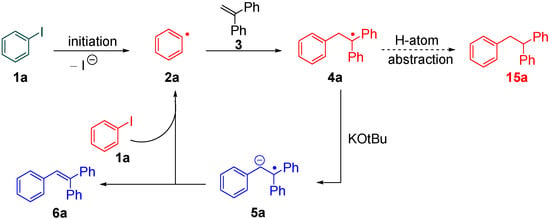
Figure 1.
Mechanism of the coupling of iodoarenes to styrenes.
Two other research groups reported closely related findings in the same year. Shi et al., observed [13] intermolecular and intramolecular couplings of iodoarenes to 1,1-diphenylethenes, mediated by KOtBu in benzene as solvent at 110 °C., but in the presence of phenanthrolines as additives. Taking phenanthroline itself in Figure 2 as an example, they proposed that the phenanthroline complex of KOtBu 7 acted as an electron donor to the aryl halide to initiate the radical reactions. Rueping et al., likewise [14] used phenanthroline and KOtBu to bring about intramolecular coupling of iodoaryl moieties with styryl and 1,1-diphenylethenyl groups. More recently, Rossi et al. [1] reported a new version of the Hayashi process (i.e., in the absence of organic additives), using photostimulation to enhance the initiation.
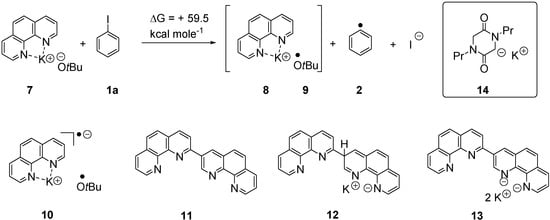
Figure 2.
Species potentially involved in the electron-transfer initiation reactions.
The issue of electron transfer when KOtBu reacts in these reactions is of much current interest. For a phenanthroline complex, 7, Tuttle, Murphy et al. [15] showed that electron transfer to iodobenzene would have a thermodynamic difference between starting materials and products ∆G = +59.5 kcal·mol−1, when calculated at the M06L/6-311G(d,p) level of theory using the CPCM continuum solvation method to incorporate the polarizing effect of the benzene solvent. It is stressed that this is not the kinetic barrier, which is likely to be considerably higher. The reaction is so endergonic as to make such an electron transfer untenable in ground state chemistry. Moreover they isolated a single distinctive product, 11, resulting from in situ dimerisation of phenanthroline and quenching by an electron acceptor (in this case, iodine). This drove them to propose that the strong electron donors, anion 12 and/or dianion 13, are produced during these reactions and may play a crucial role in the electron transfer steps.
Since then, Wilden et al., reported [16] evidence for decomposition products of tert-butoxyl radical in coupling reactions, and therefore supporting the role of electron transfer from tert-butoxide anion. In their case, they proposed that the electron transfer occurs to the phenanthroline to form the phenanthroline radical anion that then acts as the electron donor. Very recently, Lei, Jutand et al., proposed [17] that the phenanthroline radical anion, resulting from electron transfer from butoxide to phenanthroline, is the active electron donor although, surprisingly, they do not cite the Wilden paper [16] that came to the same conclusion. Both of these papers cite the Tuttle and Murphy [15] paper, but Wilden comments on our computational results and doesn’t discuss the experimental results including the isolation of 11 and its implications, while Lei and Jutand mention the paper only in the context that it reports that the “mechanism of action of 1,2-diamines” as organic additives in similar reactions is not yet clarified (that was not studied in the paper) but don’t discuss the core findings of the paper. A further paper has appeared from Yuan et al. [18] that uses a photoactivated complex of KOtBu with phenanthroline, but cites none of these papers.
In the absence of phenanthroline additives, (i.e., the conditions used by Hayashi), Murphy and Tuttle [15] proposed that traces of benzyne, formed from reaction of KOtBu with iodoarenes, can initiate the reactions [1]. To date, phenanthrolines are the only organic additives to have triggered these reactions. In exploring the scope of the coupling reactions and in understanding the roles of organic additives, it would be helpful to explore alternative compounds that perform a similar role. That is the task of this paper.
2. Results and Discussion
Very recently, Tuttle and Murphy et al. reported [19] that the enolate 14 of N,N'-dialkyldiketopiperazine 16 could act as an electron donor and trigger coupling reactions between aryl halides and arenes. In coupling haloarenes to arenes, a number of authors had previously found that aminoacids, in the presence of KOtBu, played a helpful role [9,20,21]. Moreover, it seemed that N-monoalkyl aminoacids (i.e., secondary aminoacids) were more helpful than primary aminoacids. We recently suggested that this might be explained if the secondary aminoacids underwent condensation reactions in situ, that could lead to N,N'-dialkyldiketopiperazines [19]. In turn, these could be deprotonated to form enolates that would act as electron donors. Regardless of whether that happens for secondary amino acids, our interest in the possible role of enolates such as 14 was heightened. This paper now investigates the coupling of iodoarenes with styrenes and 1,1-diphenylethenes in the presence of KOtBu and N,N'-dialkyldiketopiperazines.
The prototype reaction used for the study was the coupling of iodobenzene (1a) to 1,1-diphenylethene 3 (Table 1). In the presence of 16 (0.5 equiv), and heating in benzene for 16 h at 100 °C (entry 1) afforded products 6a (11%) and 15a (18%). Product 15a presumably arises from coupling of the aryl radical to the alkene; hydrogen abstraction by this radical then occurs more rapidly than deprotonation to form radical anion 5a, the precursor of 6a. Table 1 explores the optimisation of this reaction, in which various solvents (DMSO, DMF, benzene), different temperatures and different numbers of equivalents of butoxide, of the diketopiperazine and of the diphenylethene were used. The most successful conditions for forming coupling products are shown in entries 10 and 11. In entry 10, the number of equivalents of 16 is at a minimum (0.05), while the number of equivalents of KOtBu (10) is at a maximum. The latter helps to maximize the formation of 6a, since under these conditions, the deprotonation of the benzylic radical 4a is most likely, thereby leading to the product 6a, following electron transfer. On the other hand, conditions for entry 11 minimize the concentration of KOtBu, but uses higher concentrations of the diketopiperazine 16 and this leads to 15 as the predominant product. In this Table, Entry 8 shows the importance of using KOtBu, as potassium carbonate is not effective in affording coupling. Entry 12 shows that the diketopiperazine 16 is required to afford the products; in its absence, only a trace of product formed. This is in keeping with the proposed initiator role of enolate 14 as an electron donor.

Table 1.
Optimisation conditions for the coupling of iodobenzene 1a to 1,1-diphenylethene 3. 

| Entry | 3 (Equiv.) | 16 (Equiv.) | Base (Equiv.) | Solvent | T (°C) | Reaction Time (h) | 6a (%) a | 15a (%) a |
|---|---|---|---|---|---|---|---|---|
| 1 | 1 | 0.5 | KOtBu (3) | benzene | 100 | 16 | 11 | 18 |
| 2 | 1 | 0.1 | KOtBu (5) | benzene | 110 | 16 | 22 | 13 |
| 3 | 1 | 0.1 | KOtBu (5) | benzene | 160 | 16 | 25 | 8 |
| 4 | 1 | 0.1 | KOtBu (5) | DMSO | 160 | 16 | -- b | -- b |
| 5 | 3 | 0.1 | KOtBu (5) | DMF | 160 | 16 | 6 | 13 |
| 6 | 3 | 0.3 | KOtBu (3) | benzene | 110 | 36 | 25 | 43 |
| 7 | 5 | 0.1 | KOtBu (6) | benzene | 110 | 36 | 36 | 26 |
| 8 | 5 | 0.1 | K2CO3 (6) | benzene | 110 | 36 | 0 | 0 |
| 9 | 5 | 0.2 | KOtBu (6) | benzene | 110 | 36 | 25 | 42 |
| 10 | 5 | 0.05 | KOtBu (10) | benzene | 110 | 36 | 58 | 14 |
| 11 | 5 | 0.3 | KOtBu (1.5) | benzene | 110 | 36 | 20 | 63 |
| 12 | 5 | - | KOtBu (6) | benzene | 110 | 36 | trace | trace |
Notes: Reactions were carried out using 0.5 mmol of 1a in a sealed pressure tube and provided 1%–5% of biphenyl product (except for Entries 5 and 8) along with 6a and 15a. a Isolated product yields. b Starting material was decomposed.
These optimised conditions of entry 10 were then applied to the formation of coupled alkene products 6. Figure 3 shows the outcomes. With the exception of the naphthalene cases arising from 1-bromonaphthalene, in each case, a mixture of two products, the triarylethene 6 and triarylethane 15, was formed. Where separation of the two products was possible, their isolated yields are quoted as the percentages above. In some cases, separation of the two products was not possible and, there, an overall yield is followed by a ratio of the two products. In each case, the alkene predominates, with the ratios varying from 2.5:1 to more than 5.5:1. In the case of 1-bromonaphthalene, it appears that very easy elimination to the corresponding benzyne occurred. Addition of tert-butoxide occurred selectively at the 2-position, ultimately affording 2-t-butoxynaphthalene 17 [22]. Even allowing for that, 1-naphthyl radicals were clearly also formed as shown by the formation of 6g and 15g. It is not clear why the alkene product, 6g, was not isolated in greater yield in this case.
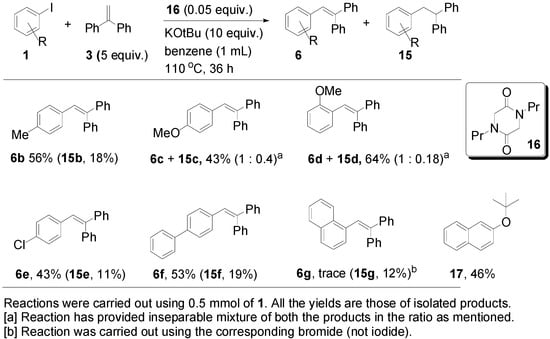
Figure 3.
Scope of the formation of alkene products 6.
Returning to Table 1, entry 11 showed the optimised conditions for the formation of the 1,1,2-triarylethanes 15. Here, far less KOtBu (1.5 equiv) was used, and the amount of diketopiperazine 16 was higher (0.3 equiv) than for entry 10. Figure 4 reports our studies on optimization of the yields of 15. It should be noted that while the formation of the alkene product 6 leads to continuation of a radical chain shown in Figure 1, the formation of 15 does not.
At the end of the addition sequence, hydrogen abstraction is required, and the most likely source of that hydrogen is the molecule 16, since abstraction from one of its CH2 groups would afford a stabilized captodative radical. However, there is a deficiency of this molecule (only 0.3 equiv), and since more than 60% of product 15 is formed this suggests that each molecule of 16 provides more than one hydrogen atom. This will be discussed further below (Figure 7). With 1-bromonaphthalene, 1,1,2-triarylethane product 15g (46%) was formed in preference to 1,1,2-triarylethene 6g (trace amounts), but 2-t-butoxynaphthalene 17 was again isolated (8%).
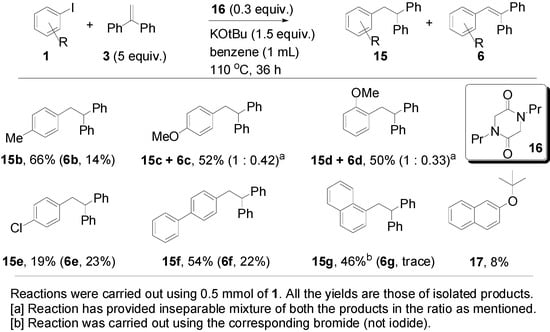
Figure 4.
Scope of the formation of triarylethane products 15.
Proceeding to test the reaction in coupling with styrenes (Figure 5), it is clear that the reaction affords yields that are lower than for 1,1-diphenylethenes. Iodides work better than bromides, and the higher temperature of 130 °C works better than lower temperatures.
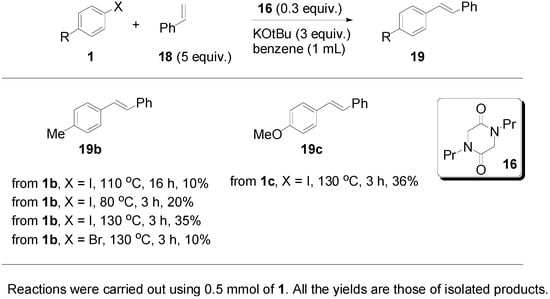
Figure 5.
Formation of stilbene products from styrenes.
In reaching the unsaturated products, the importance of the acidity of the proton to be removed in transforming benzylic radical 4 to the corresponding radical anion 5 (Figure 1) is key. This is seen in comparing the cyclisations of substrates 20 and 23 (Figure 6). Cyclisation of the aryl radical derived from iodoarene 20 onto the diphenylethene affords benzylic radical 26. Deprotonation of this radical gives a radical anion 27 that can delocalize over the three aromatic rings. Hence the diphenylethene 28 can form in good yield, allowing the chain reaction to continue. Either during the reaction or on work up, isomerisation of the stilbene central double-bond in 28 occurs to afford the benzofuran 21. In contrast, deprotonation of the radical resulting from cyclisation of the aryl radical arising from 23 does not lead to such a delocalized radical anion, and so the deprotonation is relatively inhibited, with hydrogen atom abstraction occurring instead to form 24.

Figure 6.
The importance of acidity in forming alkene products.
The importance of the hydrogen abstraction step is revisited in Figure 7. Here two diketopiperazines 16 and 29 were compared, mindful of what was said above about hydrogen abstraction. The two additives gave very different results. Compound 16 afforded significantly higher yield (66%) of the reduced compound 15b, indicating that the additional CH2 group in 16 plays a major role in determination of the pathways to product. Since 0.3 equiv of the N,N'-dialkyl diketopiperazine 16 was used, and more than 60% of dihydrostilbene product 15b formed, it suggests that on average the N,N'-dialkyl diketopiperazine, as the likely source for hydrogen atom abstraction, can be responsible for providing two hydrogen atoms.
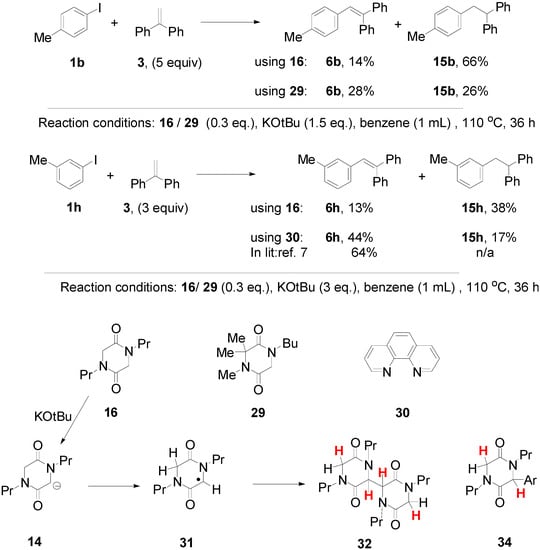
Figure 7.
The importance of hydrogen atom abstraction.
If the diketopiperazine requires to be deprotonated to 14, and later transforms into radical 31 following electron transfer then, in either case, only a single hydrogen from the remaining methylene group would be available for hydrogen atom abstraction. However, if dimerization of radical 31 to 32 should occur [23] (32 could also arise by combination of radical 31 with anion 14, followed by electron transfer) or if combination of 31 with another radical (e.g., an aryl radical) to form 34 should occur, then additional hydrogens come into play (shown in red in Figure 7), that can account for the observed yields of products.
The results from the m-tolyl case 1h were less pronounced, but comparison with the experiment using phenanthroline 30 shows that the yield of saturated product 15h is enhanced when the diketopiperazine is used. The literature [13] reports a 64% yield of the stilbene, whereas our experiments afford a 61% yield, (but as a 44% + 17% mixture of the stilbene and the dihydrostilbene product).
3. Experimental Section
3.1. General Information
All the reactions were performed in oven-dried or flame-dried apparatus and preparation of the substrates was carried out under argon atmosphere using dry solvents. Diethyl ether, tetrahydrofuran, dichloromethane and hexane were dried with a Pure-Solv 400 solvent purification system by Innovative Technology Inc., Amesbury, MA, USA. A glove box (Innovative Technology Inc., Amesbury, MA, USA) was used to weigh out the super-electron-donor (SED) into the reaction flask. All the reagents were bought from commercial suppliers and used without further purification unless stated otherwise. A Büchi rotary evaporator was used to concentrate the reaction mixtures. Thin layer chromatography (TLC) was performed using aluminum-backed sheets of silica gel and visualized under a UV lamp (254 nm). The plates were developed using vanillin or KMnO4 solution. Column chromatography was performed to purify compounds by using silica gel 60 (200–400 mesh).
Proton (1H) NMR spectra were recorded at 400 MHz on a Bruker DPX 400 spectrometer or at 500 MHz on a Bruker DRX 500 spectrometer. Carbon NMR (13C) spectra were recorded at 100 MHz or 125 MHz respectively. The chemical shifts are quoted in parts per million (ppm) by taking tetramethylsilane as a reference (δ = 0) but calibrated on the residual non-deuterated solvent signal. Signal multiplicities are abbreviated as: s, singlet; d, doublet; t, triplet; q, quartet; m, multiplet; bs, broad singlet; coupling constants are given in Hertz (Hz).
Infra-Red spectra were recorded on a Perkin Elmer Spectrum One FT IR Spectrometer either pressed as discs in KBr or as films applied on NaCl crystal plates or using Shimadzu FT-IR Spectrophotometer (Model IRAffinity-1) with a MIRacle Single Reflection Horizontal ATR Accessory. Melting points were determined on a Gallenkamp Melting point apparatus. High resolution mass spectra were recorded at the EPSRC National Mass Spectrometry Service Centre, Swansea. The spectra were recorded using electron ionization (EI), chemical ionization (CI), fast atom bombardment (FAB) or electrospray ionization (ESI) techniques as stated for each compound.
3.2. Preparation of Piperazinediones
3.2.1. Synthesis of Compound 16

Chloroacetyl chloride (5.60 g, 50 mmol) was added dropwise to a flask containing a solution of n-propylamine (5.9 g, 100 mmol) in DCM (50 mL) cooled in an ice-water bath. The resulting reaction mixture was stirred in the cooling ice bath for 1 h, diluted with ether (100 mL), and filtered. The filtrate was then concentrated. The residue was again dissolved in ether (100 mL) and the solid was filtered. Concentration of the filtrate provided 2-chloro-N-propylacetamide (6.73 g, 100%) as a pure pale yellow oil. The product was used without further purification [19].

To a flask containing a suspension of NaH (1.80 g, 45 mmol) in dry THF (10 mL) was added dropwise a solution of 2-chloro-N-propylacetamide (6.076 g, 45 mmol) in dry THF (30 mL) at 0 °C, under argon gas flow. After the completion of the addition, the resulting reaction mixture was stirred at room temperature for 3 h. Then the mixture was diluted with ether (70 mL) and filtered. The filtrate was concentrated and purified by column chromatography (hexane/EtOAc = 50/50 → 100% EtOAc). 1,4-Di-n-propylpiperazine-2,5-dione 16 [19] (723 mg, 73%) was obtained as a white solid. mp, 40 °C–42 °C; νmax (neat)/cm−1 2965, 2934, 2874, 1653, 1482, 1336, 1310, 1279, 1206, 1057; [Found: (FTMS+) (M+H)+ 199.1439, C10H19N2O2 (M+H) requires 199.1441]; 1H-NMR (400 MHz, CDCl3): δ 0.93 (6H, t, J = 7.2 Hz, NCH2CH2CH3), 1.55–1.63 (4H, m, NCH2CH2CH3), 3.35–3.39 (4H, m, NCH2CH2CH3), 3.96 (4H, s, COCH2N); 13C-NMR (100 MHz, CDCl3): δ 11.2 (CH3), 20.1 (CH2), 47.7 (CH2), 50.1 (CH2), 163.6 (C).
3.2.2. Synthesis of Compound 29

To a suspension of 2-amino-2-methylpropanoic acid (5.25 g, 50.97 mmol) in MeOH (60 mL), cooled in an ice-water bath, was added thionyl chloride (3.9 mL, 53.7 mmol) dropwise over about 20 min. The resulting solution was heated to 55–60 °C for 4 h, then cooled to room temperature, and concentrated. More MeOH (50 mL) was added, and concentrated under vacuum. The white solid obtained was used in the next reaction without purification.
Crude methyl 2-amino-2-methylpropanoate hydrogen chloride salt was dissolved in water. NaHCO3 (12.9 g, 153 mmol) was added, followed by chloroform (30 mL). The 2-chloroacetyl chloride (4.4 mL, 55 mmol) in chloroform (5 mL) was added dropwise. The mixture was stirred at room temperature overnight. The organic layer was separated. The aqueous layer was extracted with chloroform (30 mL). The combined organic layer was dried over Na2SO4, filtered and concentrated. Column purification (EtOAc) of the crude product provided methyl 2-(2-chloroacetamido)-2-methyl propanoate, (5.47 g, 56% over two steps) as a white solid that was used in the next step [19].
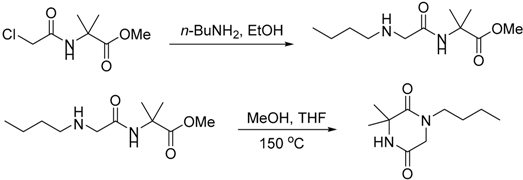
A solution of 2-(2-chloroacetamido)-2-methyl propanoate (850 mg, 4.41 mmol) and n-BuNH2 in ethanol (15 mL) was heated at 55 °C for 3 h, and the mixture was cooled to room temperature. The volatiles were removed on a rotary evaporator. The residue was dissolved in EtOAc and washed with aqueous potassium carbonate solution (5 mL, containing K2CO3 (1.0 g). The organic layer was separated and concentrated. The residue was dissolved in MeOH (5 mL) and THF (5 mL), sealed in a pressure tube and heated to 150 °C overnight behind a shield. The mixture was cooled to room temperature. The solvent was removed under vacuum, and the residue was purified by column chromatography (EtOAc). 1-Butyl-3,3-dimethylpiperazine-2,5-dione [19] was obtained as a white solid, (645 mg, 74% over two steps). mp 78–80 °C; νmax (neat)/cm−1 3073, 2963, 2930, 2872, 1682, 1645, 1450, 1427, 1298, 1196, 825, 785; [Found: (FTMS) (M+H)+ 199.1438, C10H19N2O2 (M+H) requires 199.1441]; 1H-NMR (400 MHz, CDCl3): δ 0.94 (3H, t, J = 7.3 Hz), 1.29–1.38 (2H, m), 1.49 (6H, s), 1.50–1.58 (2H, m), 3.4 (2H, t, J = 7.4 Hz), 3.96 (2H, s), 7.55 (1H, broad); 13C-NMR (100 MHz, CDCl3): δ 13.2, 19.4, 27.3, 28.2, 45.8, 49.4, 55.5, 165.7, 168.6.

To a solution of 1-butyl-3,3-dimethylpiperazine-2,5-dione (220 mg, 1.11 mmol) in THF (8 mL) cooled in an ice-water bath under argon was added n-BuLi (0.5 mL, 1.25 mmol) dropwise. The mixture was stirred at room temperature for 10 min, then it was cooled in ice-water bath again. Iodomethane (0.2 mL) was added and the mixture was stirred at room temperature overnight. The reaction was quenched by water (30 mL). The mixture was extracted with EtOAc (2 × 30 mL). The organic layer was dried over Na2SO4, filtered and concentrated. Purification by column chromatography (EtOAc) gave 1-butyl-3,3,4-trimethylpiperazine-2,5-dione 29 [19] as a yellow oil (118 mg, 50%). νmax (neat)/cm−1 2959, 2932, 2875, 1651, 1456, 1429, 1400, 1379, 1308, 1211, 1153, 989, 752; [Found: (FTMS) (M+H)+ 213.1594, C11H21N2O2 (M+H) requires 213.1598]; 1H-NMR (400 MHz, CDCl3): δ 0.85 (3H, t, J = 7.3 Hz), 1.25–1.29 (2H, m), 1.39–1.50 (2H, m), 1.43 (6H, s), 2.89 (3H, s), 3.13 (2H, t, J = 7.4 Hz), 3.89 (2H, s); 13C-NMR (100 MHz, CDCl3): δ 13.2, 19.3, 24.2, 27.2, 28.0, 45.7, 48.9, 60.1, 163.6, 168.0.
3.3. Synthesis of (3-(2-Iodophenoxy)prop-1-ene-1,1-diyl)dibenzene (20)

To a flask equipped with condenser, magnesium turnings (0.583 g, 24 mmol), iodine (50 mg), and dry THF (20 mL) were added and the flask was kept under argon gas flow. Vinyl bromide (1 M in THF, 24 mL, 24 mmol) was added drop-wise into the flask while heating the reaction mixture at 40 °C. Later, the resulting reaction mixture was stirred for 1 h at 50 °C before cooling it to room temperature. This solution was then added dropwise using a cannula into another flask containing benzophenone (3.644 g, 20 mmol) in THF (20 mL) at −78 °C. The resulting reaction mixture was then warmed to room temperature and stirred for 16 h. Reaction contents were then quenched with ice and extracted with diethyl ether (3 × 30 mL). The combined ether layers were washed with water (15 mL), brine (15 mL), dried over anhydrous Na2SO4, filtered and concentrated using rotary evaporator. Purification of the crude product by column chromatography (15% EtOAc in hexane) afforded 1,1-diphenylprop-2-en-1-ol [13] (2.691 g, 64%).
A solution of phosphorus tribromide (2.7016 g, 10.0 mmol) was added drop-wise to a flask containing 1,1-diphenylprop-2-en-1-ol (1.892 g, 9 mmol) and pyridine (0.711 g, 9 mmol) in dry tetrahydrofuran (20 mL) at 0 °C under argon gas. The resulting solution was warmed to room temperature and further stirred for 16 h. At this point, the reaction was quenched with water (10 mL) and extracted with diethyl ether (3 × 10 mL). The combined ether layers were washed with water (10 mL), brine (10 mL), dried over anhy. Na2SO4, filtered, concentrated using rotary evaporator and afforded (3-bromoprop-1-ene-1,1-diyl)dibenzene [13] (1.516 g, 62%).
To a flask containing K2CO3 (0.691 g, 5 mmol) in acetone (20 mL) was added with 2-iodophenol (0.660 g, 3 mmol) in acetone (2 mL) and (3-bromoprop-1-ene-1,1-diyl)dibenzene (0.682 g, 2.5 mmol) in acetone (2 mL) at room temperature and the resulting reaction mixture was stirred at reflux conditions for 16 h. At this point, the reaction was quenched with water (10 mL) and extracted with diethyl ether (3 × 15 mL). The combined ether layers were washed with water (10 mL), brine (10 mL), dried over anhydrous Na2SO4, filtered, concentrated using rotary evaporator. The crude product was then purified by column chromatography (2% diethyl ether in hexane) to afford desired (3-(2-iodophenoxy)prop-1-ene-1,1-diyl)dibenzene 19 [13] (0.746 g, 72%) as a viscous pale yellow oil. νmax (neat)/cm−1 3057, 3023, 1580, 1470, 1441, 1377, 1241, 1020, 731; 1H-NMR (400 MHz, CDCl3) δ 4.67 (2H, d, J = 6.8 Hz, ArOCH2), 6.38 (1H, t, J = 6.8 Hz, HC = CPh2), 6.66–6.72 (2H, m, ArH), 7.20–7.31 (8H, m, ArH), 7.36–7.44 (3H, m, ArH), 7.79 (2H, dd, J = 7.6, 1.6 Hz, ArH); 13C-NMR (100 MHz, CDCl3) δ 67.5 (CH2), 87.1 (C), 113.0 (CH), 122.8 (CH), 123.6 (CH), 127.9 (CH), 128.0 (CH), 128.3 (CH), 128.5 (CH), 129.4 (CH), 129.9 (CH), 139.0 (C), 139.6 (CH), 141.6 (C), 146.0 (C), 157.4 (C). Spectral data of this compound were consistent with literature data [13].
3.4. Synthesis of 1-Iodo-2-((3-methylbut-2-en-1-yl)oxy)benzene (23)

To a flask containing K2CO3 (0.829 g, 6 mmol) in acetone (20 mL) was added with 2-iodophenol (0.968 g, 4.4 mmol) in acetone (2 mL) and 1-bromo-3-methylbut-2-ene (0.596 g, 4 mmol) in acetone (2 mL) at room temperature and the resulting reaction mixture was stirred at reflux conditions for 16 h. At this point, the reaction was quenched with water (10 mL) and extracted with diethyl ether (3 × 15 mL). The combined ether layers were washed with water (10 mL), brine (10 mL), dried over anhy. Na2SO4, filtered, concentrated using rotary evaporator. The crude product was then purified by column chromatography (2% diethyl ether in hexane) to afford desired 1-iodo-2-((3-methylbut-2-en-1-yl)oxy)benzene (0.719 g, 62%) as a colourless oil. νmax (neat)/cm−1 3060, 2913, 2930, 1582, 1470, 1439, 1383, 1275, 1230, 1050, 1018, 746; 1H-NMR (400 MHz, CDCl3) δ 1.76 (3H, s, CH3), 1.80 (3H, s, CH3), 4.59 (2H, d, J = 6.8 Hz, ArOCH2), 5.50–5.54 (1H, m, HC = C(CH3)2), 6.71 (1H, td, J = 7.6, 1.6 Hz, ArH), 6.83 (1H, d, J = 8.0, 1.2 Hz, ArH), 7.26–7.31 (1H, m, ArH), 7.78 (1H, dd, J = 8.0, 1.6 Hz, ArH); 13C-NMR (100 MHz, CDCl3) δ 18.5 (CH3), 25.9 (CH3), 66.4 (CH2), 87.1 (C), 112.8 (CH), 119.6 (CH), 122.5 (CH), 129.4 (CH), 138.0 (C), 139.6 (CH), 157.6 (C). Spectral data of this compound were consistent with literature data [24].
3.5. General Reaction Procedure
Substrate (0.5 mmol) and additive were added to a pressure tube. KOtBu and benzene were added into the tube in a glove box. The tube was then sealed properly before removing from the glove box and reaction was done as described in the Tables (time and temperature). Later, the pressure tube was cooled to room temperature. The reaction was quenched with water (10 mL) and extracted with diethyl ether (3 × 15 mL). The combined ether layers were then washed with water (10 mL), brine (10 mL) and dried over anhydrous sodium sulfate. The crude product was obtained after evaporation of solvent under reduced pressure using a rotary evaporator. The crude product was then adsorbed onto silica and purified by column chromatography (100% hexane), providing the corresponding coupling products.
3.5.1. Data for Compound 6a

White solid m.p. 70–72 °C (lit.: [25] 70 °C). νmax (neat)/cm−1 3057, 3023, 1601, 1493, 1446, 1078, 1033, 908, 731; 1H-NMR (400 MHz, CDCl3) δ 6.98 (1H, s, ArCH = CPh2), 7.03–7.05 (2H, m, ArH), 7.11–7.15 (3H, m, ArH), 7.21–7.23 (2H, m, ArH), 7.29–7.36 (8H, m, ArH); 13C-NMR (100 MHz, CDCl3) δ 126.9 (CH), 127.5 (CH), 127.6 (CH), 127.7 (CH), 128.1 (CH), 128.3 (CH), 128.34 (CH), 128.8 (CH), 129.7 (CH), 130.5 (CH), 137.5 (C), 140.5 (C), 142.7 (C), 143.6 (C). Spectral data of this compound were consistent with literature data [26].
3.5.2. Data for Compound 15a

White solid m.p. 50–52 °C (lit.: [20] 50–52 °C). νmax (neat)/cm−1 3062, 3027, 2935, 1601, 1495, 1448, 1070, 1031, 694; 1H-NMR (400 MHz, CDCl3) δ 3.38 (2H, d, J = 7.6 Hz, ArCH2CH), 4.24 (1H, t, J = 7.6 Hz, ArCH2CH), 7.00–7.02 (2H, m, ArH), 7.11–7.28 (3H, m, ArH); 13C-NMR (100 MHz, CDCl3) δ 42.2 (CH2), 53.2 (CH), 126.0 (CH), 126.3 (CH), 128.2 (CH), 128.5 (CH), 129.2 (CH), 140.4 (C), 144.6 (2 × C). Spectral data of this compound were consistent with literature data [27].
3.5.3. Data for Compound 6b

White solid m.p. 70–72 °C (lit.: [26] 69–70 °C). νmax (neat)/cm−1 3079, 3055, 3023, 1599, 1495, 1446, 1031, 908, 698; 1H-NMR (400 MHz, CDCl3) δ 2.28 (3H, s, CH3), 6.91–6.97 (5H, m, ArH + =CH), 7.21–7.24 (2H, m, ArH), 7.27–7.35 (8H, m, ArH); 13C-NMR (100 MHz, CDCl3) δ 21.3 (CH3), 127.4 (CH), 127.5 (CH), 127.6 (CH), 128.2 (CH), 128.3 (CH), 128.8 (CH), 128.9 (CH), 129.6 (CH), 130.5 (CH), 134.7 (C), 136.7 (C), 140.7 (C), 141.8 (C), 143.7 (C). Spectral data of this compound were consistent with literature data [26].
3.5.4. Data for Compound 15b

White solid m.p. 78–80 °C (lit.: [28] 80 °C). νmax (neat)/cm−1 3084, 3025, 2917, 1601, 1493, 1452, 1035, 1022, 700; 1H-NMR (400 MHz, CDCl3) δ 2.28 (3H, s, CH3), 3.34 (2H, d, J = 7.6 Hz, ArCH2CH), 4.23 (1H, t, J = 7.6 Hz, ArCH2CH), 6.91 (2H, d, J = 7.2 Hz, ArH), 6.99 (2H, d, J = 8.0 Hz, ArH), 7.15–7.19 (2H, m, ArH), 7.22–7.28 (8H, m, ArH); 13C-NMR (100 MHz, CDCl3) δ 21.1 (CH3), 41.8 (CH2), 53.3 (CH), 126.3 (CH), 128.2 (CH), 128.5 (CH), 128.9 (CH), 129.0 (CH), 135.4 (C), 137.3 (C), 144.6 (2 × C). Spectral data of this compound were consistent with literature data [28].
3.5.5. Data for Compound 6e

Colourless viscous oil. νmax (neat)/cm−1 3057, 3023, 1493, 1444, 1053, 1037, 908, 731; [Found: (CI+ corona) (M+H)+ 291.0937 C20H16Cl (M+H) requires 291.0935]; 1H-NMR (400 MHz, CDCl3) δ 6.82–6.84 (1H, m, ArH), 6.87–6.91 (1H, m, ArH), 7.04–7.08 (1H, m, ArH), 7.10 (1H, s, ArCH=CPh2), 7.14–7.16 (2H, m, ArH), 7.26–7.28 (3H, m, ArH), 7.32–7.38 (6H, m, ArH); 13C-NMR (100 MHz, CDCl3) δ 125.2 (CH), 126.1 (CH), 127.6 (CH), 128.0 (CH), 128.2 (CH), 128.4 (CH), 128.5 (CH), 129.4 (CH), 130.8 (CH), 131.3 (CH), 134.7 (C), 136.4 (C), 139.9 (C), 143.1 (C), 144.8 (C); m/z (CI+ corona) 291 [(M+H)+, 34%], 197 (22), 181 (100), 111 (14). Spectral data of this compound were consistent with literature data [13].
3.5.6. Data for Compound 15e

White solid m.p. 54–56 °C. νmax (neat)/cm−1 3062, 3027, 1603, 1496, 1450, 1053, 1040, 754; [Found: (CI+ corona) (M+NH4)+ 310.1351. C20H21NCl (M+NH4) requires 310.1357]; 1H-NMR (400 MHz, CDCl3) δ 3.49 (2H, d, J = 7.6 Hz, ArCH2), 4.40 (1H, t, J = 7.6 Hz, ArCH2CH), 6.81 (1H, dd, J = 7.6, 1.6 Hz, ArH), 6.97 (1H, td, J = 7.6, 1.6 Hz, ArH), 7.08 (1H, td, J = 7.6, 1.6 Hz, ArH), 7.16–7.29 (10H, m, ArH), 7.33 (1H, dd, J = 8.0, 1.2 Hz, ArH) 13C-NMR (100 MHz, CDCl3) δ 39.9 (CH), 50.8 (CH2), 126.4 (CH), 126.42 (CH), 127.6 (CH), 128.3 (CH), 128.5 (CH), 129.5 (CH), 131.5 (CH), 134.4 (C), 137.8 (C), 144.2 (2 × C); m/z (CI+ corona) 310 [(M+NH4)+, 9%], 215 (18), 167 (100), 149 (20).
3.5.7. Data for Compound 6f
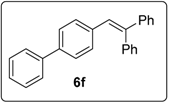
White solid m.p. 110–112 °C (lit.: [29] 113–114 °C). νmax (neat)/cm−1 3053, 3023, 1601, 1493, 1444, 1078, 735; 1H-NMR (500 MHz, CDCl3) δ 7.03 (1H, s, ArCH=CPh2), 7.12 (2H, d, J = 8.5 Hz, ArH), 7.26–7.43 (15H, m, ArH), 7.57 (2H, d, J = 8.0 Hz, ArH); 13C-NMR (100 MHz, CDCl3) δ 126.7 (CH), 127.0 (CH), 127.4 (CH), 127.6 (CH), 127.7 (CH), 127.74 (CH), 127.8 (CH), 128.4 (CH), 128.86 (CH), 128.88 (CH), 130.1 (CH), 130.5 (CH), 136.6 (C), 139.5 (C), 140.6 (C), 140.7 (C), 142.8 (C), 143.6 (C). Spectral data of this compound were consistent with literature data [30].
3.5.8. Data for Compound 15f
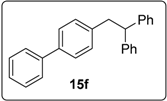
White solid m.p. 128–130 °C. νmax (neat)/cm−1 3084, 3062, 3029, 1601, 1491, 1452, 1081, 1011, 765; [Found: (CI+ corona) (M+NH4)+ 352.2056. C26H26N (M+NH4) requires 352.2060]; 1H-NMR (400 MHz, CDCl3) δ 3.42 (2H, d, J = 7.6 Hz, ArCH2CH), 4.29 (1H, t, J = 7.6 Hz, ArCH2CH), 7.09 (2H, d, J = 8.0 Hz, ArH), 7.16–7.20 (2H, m, ArH), 7.24–7.34 (9H, m, ArH), 7.39–7.43 (4H, m, ArH), 7.55–7.57 (2H, m, ArH); 13C-NMR (100 MHz, CDCl3) δ 41.9 (CH2), 53.1 (CH), 126.4 (CH), 126.9 (CH), 127.0 (CH), 127.1 (CH), 128.2 (CH), 128.5 (CH), 128.8 (CH), 129.6 (CH), 138.8 (C), 139.5 (C), 141.1 (C), 144.6 (2 × C); m/z (CI+ corona) 352 [(M+NH4)+, 22%], 333 [(M−H)+, 38%], 249 (11), 195 (14), 171 (100), 149 (10).
3.5.9. Data for Compound 17

Colourless oil. νmax (neat)/cm−1 3057, 2976, 2932, 1632, 1597, 1508, 1467, 1366, 1251, 1154, 1122, 968, 867, 752; 1H-NMR (400 MHz, CDCl3) δ 1.43 (9H, s, CCH3), 7.20 (1H, dd, J = 8.8, 2.4 Hz, ArH), 7.37–7.47 (3H, m, ArH), 7.66 (2H, d, J = 8.4 Hz, ArH), 7.81 (1H, d, J = 8.4 Hz, ArH); 13C-NMR (100 MHz, CDCl3) δ 29.1 (CH3), 79.1 (C), 119.9 (CH), 124.6 (CH), 125.1 (CH), 126.1 (CH), 127.3 (CH), 127.7 (CH), 128.7 (CH), 130.4 (C), 134.2 (C), 153.3 (C). Spectral data of this compound were consistent with literature data [31].
3.5.10. Data for Compound 15g
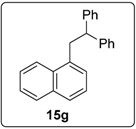
White solid m.p. 90–92 °C. νmax (neat)/cm−1 3062, 3021, 2963, 1597, 1493, 1450, 1398, 1264, 1033, 1018, 782; [Found: (CI+ corona) (M+NH4)+ 326.1895. C24H24N (M+NH4) requires 326.1903]; 1H-NMR (400 MHz, CDCl3) δ 3.84 (2H, d, J = 7.6 Hz, ArCH2CH), 4.48 (1H, t, J = 7.6 Hz, ArCH2CH), 6.92 (1H, d, J = 6.4 Hz, ArH), 7.18–7.30 (11H, m, ArH), 7.49–7.54 (2H, m, ArH), 7.69 (1H, d, J = 8.4 Hz, ArH), 7.87–7.89 (1H, m, ArH), 8.06–8.09 (1H, m, ArH); 13C-NMR (100 MHz, CDCl3) δ 39.4 (CH2), 51.8 (CH), 123.8 (CH), 125.3 (CH), 125.5 (CH), 126.0 (CH), 126.4 (CH), 126.9 (CH), 127.4 (CH), 128.2 (CH), 128.5 (CH), 129.0 (CH), 132.1 (C), 134.0 (C), 136.0 (C), 144.8 (2 × C); m/z (CI+ corona) 326 [(M+NH4)+, 22%], 307 [(M−H)+, 42%], 229 (100), 167 (50), 153 (25).
3.5.11. Data for Compound 18b

White solid m.p. 116–118 °C (lit.: [25] 118–119 °C). νmax (neat)/cm−1 3051, 3027, 2921, 1599, 1513, 1450, 966, 908, 731; 1H-NMR (400 MHz, CDCl3) δ 2.38 (3H, s, ArCH3), 7.07 (1H, d, J = 16.4 Hz, ArCH=CHPh), 7.12 (1H, d, J = 16.4 Hz, ArCH=CHPh), 7.18 (2H, d, J = 8.0 Hz, ArH), 7.24–7.28 (1H, m, ArH), 7.37 (2H, t, J = 7.6 Hz, ArH), 7.43 (2H, d, J = 8.4 Hz, ArH), 7.52 (2H, d, J = 7.2 Hz, ArH); 13C-NMR (100 MHz, CDCl3) δ 21.4 (CH3), 126.5 (CH), 126.6 (CH), 127.5 (CH), 127.9 (CH), 128.8 (CH), 129.5 (CH), 134.7 (C), 137.67 (C), 137.7 (C). Spectral data of this compound were consistent with literature data [32].
3.5.12. Data for Compound 18c

White solid m.p. 134–136 °C (lit.: [26] 136–137 °C). νmax (neat)/cm−1 3066, 3023, 2965, 2839, 1603, 1595, 1513, 1448, 1249, 1180, 1031, 815; 1H-NMR (400 MHz, CDCl3) δ 3.84 (3H, s, ArCH3), 6.91 (2H, d, J = 8.8 Hz, ArH), 6.98 (1H, d, J = 16.4 Hz, ArCH=CHPh), 7.08 (1H, d, J = 16.4 Hz, ArCH=CHPh), 7.24–7.28 (1H, m, ArH), 7.36 (2H, t, J = 8.0 Hz, ArH), 7.46–7.51 (4H, m, ArH); 13C-NMR (100 MHz, CDCl3) δ 55.4 (CH3), 114.2 (CH), 126.4 (CH), 126.7 (CH), 127.3 (CH), 127.8 (CH), 128.3 (CH), 128.8 (CH), 130.2 (C), 137.8 (C), 159.4 (C). Spectral data of this compound were consistent with literature data [33].
3.5.13. Data for Compound 20
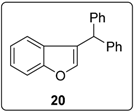
Pale yellow viscous oil. νmax (neat)/cm−1 3084, 3060, 3027, 1601, 1496, 1454, 1282, 1186, 1098, 860, 700; 1H-NMR (400 MHz, CDCl3) δ 5.54 (1H, s, CHPh2), 7.03 (1H, d, J = 1.6 Hz, OCH=C), 7.08–7.15 (2H, m, ArH), 7.23–7.34 (11H, m, ArH), 7.48 (1H, d, J = 8.4 Hz, ArH); 13C-NMR (100 MHz, CDCl3) δ 47.8 (CH), 111.6 (CH), 120.8 (CH), 122.5 (CH), 124.2 (C), 124.4 (CH), 126.9 (CH), 127.7 (C), 128.7 (CH), 128.9 (CH), 142.4 (C), 144.1 (C), 156.0 (C). Spectral data of this compound were consistent with literature data [13].
3.5.14. Data for Compound 22
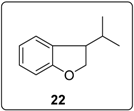
Colourless oil. νmax (neat)/cm−1 3049, 2958, 2872, 1597, 1483, 1459, 1232, 1018, 748; 1H-NMR (400 MHz, CDCl3) δ 0.89 (3H, d, J = 7.2 Hz, CH3), 0.97 (3H, d, J = 6.8 Hz, CH3), 1.94–2.02 (1H, m, CH(CH3)2), 3.31–3.36 (1H, m, ArCH), 4.39 (1H, dd, J = 9.2, 5.2 Hz, ArOCH2), 4.53 (1H, t, J = 9.2 Hz, ArOCH2), 6.78 (1H, d, J = 8.0 Hz, ArH), 6.86 (1H, td, J = 7.2, 0.8 Hz, ArH), 7.11–7.15 (1H, m, ArH), 7.19 (1H, d, J = 7.6 Hz, ArH); 13C-NMR (100 MHz, CDCl3) δ 18.6 (CH3), 19.9 (CH3), 31.8 (CH), 48.3 (CH), 74.0 (CH2), 109.5 (CH), 120.2 (CH), 125.2 (CH), 128.3 (CH), 129.6 (C), 160.6 (C). Spectral data of this compound were consistent with literature data [34].
3.5.15. Data for Compound 6h

Colourless oil. νmax (neat)/cm−1 3055, 3021, 2921, 1603, 1493, 1446, 1076, 1031, 696; 1H-NMR (500 MHz, CDCl3) δ 2.20 (3H, s, CH3), 6.81 (1H, d, J = 8.0 Hz, ArH), 6.87 (1H, s, ArCH=), 6.94 (1H, t, J = 7.5 Hz, ArH), 6.96 (1H, s, ArH), 7.02 (1H, t, J = 7.5 Hz, ArH), 7.21–7.23 (2H, m, ArH), 7.28–7.36 (8H, m, ArH); 13C-NMR (100 MHz, CDCl3) δ 21.5 (CH3), 126.7 (CH), 127.5 (CH), 127.6 (CH), 127.67 (CH), 127.7 (CH), 127.9 (CH), 128.3 (CH), 128.4 (CH), 128.7 (CH), 130.5 (CH), 130.6 (CH), 137.4 (C), 137.5 (C), 140.6 (C), 142.5 (C), 143.6 (C). Spectral data of this compound were consistent with literature data [13].
3.5.16. Data for Compound 15h

Colourless oil. νmax (neat)/cm−1 3060, 3027, 2921, 1603, 1495, 1452, 1081, 1033, 698; [Found: (CI+ corona) (M+NH4)+ 290.1899. C21H24N (M+NH4) requires 290.1903]; 1H-NMR (500 MHz, CDCl3) δ 2.25 (3H, s, CH3), 3.34 (2H, d, J = 8.0 Hz, ArCH2CH), 4.24 (1H, t, J = 8.0 Hz, ArCH2CH), 6.80 (1H, d, J = 7.5 Hz, ArH), 6.84 (1H, s, ArH), 6.95 (1H, d, J = 7.5 Hz, ArH), 7.06 (1H, t, J = 7.5 Hz, ArH), 7.15–7.19 (2H, m, ArH), 7.21–7.28 (8H, m, ArH); 13C-NMR (100 MHz, CDCl3) δ 21.5 (CH3), 42.2 (CH2), 53.2 (CH), 126.2 (CH), 126.3 (CH), 126.7 (CH), 128.0 (CH), 128.2 (CH), 128.4 (CH), 130.1 (CH), 137.6 (C), 140.3 (C), 144.7 (2 × C); m/z (CI+ corona) 290 [(M+NH4)+, 100%], 271 [(M−H)+, 28%], 195 (33), 167 (70), 111 (12).
4. Conclusions
Coupling of iodoarenes to diphenylethenes and to styrenes can be triggered by N,N'-dialkyl diketopiperazines in the presence of KOtBu. The reaction products can be largely determined by the number of equivalents of KOtBu and of the N,N'-dialkyl diketopiperazine. Increasing the amount of butoxide drives the products towards stilbene-type products, whereas increasing the number of equivalents of the N,N'-dialkyl diketopiperazine while decreasing the number of equivalents of KOtBu diverts the reaction towards dihydrostilbenes.
Supplementary Materials
Supplementary materials can be accessed at: http://www.mdpi.com/1420-3049/20/02/1755/s1.
Acknowledgments
We thank EPSRC (grant number EP/K033077/1) and University of Strathclyde for funding. High resolution mass spectra were obtained at the EPSRC National Mass Spectrometry Centre, Swansea.
Author Contributions
The experimental work was principally carried out by E.D.; the diketopiperazine 29 was prepared by S.Z. The paper was written by J.A.M. and E.D.
Conflicts of Interest
The authors declare no conflict of interest.
References
- Guastavino, J.F.; Buden, M.E.; Rossi, R.A. Room-temperature and transition-metal-free Mizoroki-Heck-type Reaction. Synthesis of E-stilbenes by photoinduced C-H functionalization. J. Org. Chem. 2014, 79, 9104–9111. [Google Scholar] [CrossRef] [PubMed]
- Beletskaya, I.P.; Cheprakov, A.V. The Heck reaction as a sharpening stone of palladium catalysis. Chem. Rev. 2000, 100, 3009–3066. [Google Scholar] [CrossRef] [PubMed]
- Braese, S.; de Meijere, A. Metal-Catalyzed Cross-Coupling Reactions, 2nd ed.; de Meijere, A., Diederich, F., Eds.; Wiley-VCH: Weinheim, Germany, 2004; pp. 217–315. [Google Scholar]
- Larhed, M.; Hallberg, A. Handbook of OrganopalladiumChemistry for Organic Synthesis; Negishi, E., de Meijere, A., Eds.; Wiley-Interscience: New York, NY, USA, 2002; Volume 1, Chapter IV.2; pp. 1133–1178. [Google Scholar]
- Ackermann, L.; Born, R. Mizoroki-Heck Reaction; Oestreich, M., Ed.; Wiley: Chichester, UK, 2009; pp. 383–403. [Google Scholar]
- Shirakawa, E.; Zhang, X.; Hayashi, T. Mizoroki-heck-type reaction mediated by potassium tert-butoxide. Angew. Chem. Int. Ed. 2011, 50, 4671–4674. [Google Scholar] [CrossRef]
- Yanagisawa, S.; Ueda, K.; Taniguchi, T.; Itami, K. Potassium t-butoxide alone can promote the biaryl coupling of electron-deficient nitrogen heterocycles and haloarenes. Org. Lett. 2008, 10, 4673–4676. [Google Scholar] [CrossRef] [PubMed]
- Sun, C.-L.; Li, H.; Yu, D.-G.; Yu, M.; Zhou, X.; Lu, X.-Y.; Huang, K.; Zheng, S.-F.; Li, B.-J.; Shi, Z.-J. An efficient organocatalytic method for constructing biaryls through aromatic C-H activation. Nat. Chem. 2010, 2, 1044–1049. [Google Scholar] [CrossRef] [PubMed]
- Liu, W.; Cao, H.; Zhang, H.; Zhang, H.; Chung, K.H.; He, C.; Wang, H.; Kwong, F.Y.; Lei, A. Organocatalysis in cross-coupling: DMEDA-catalyzed direct C-H arylation of unactivated benzene. J. Am. Chem. Soc. 2010, 132, 16737–16740. [Google Scholar] [CrossRef] [PubMed]
- Shirakawa, E.; Itoh, K.-I.; Higashino, T.; Hayashi, T. tert-Butoxide-mediated arylation of benzene with aryl halides in the presence of a catalytic 1,10-phenanthroline derivative. J. Am. Chem. Soc. 2010, 132, 15537–15539. [Google Scholar] [CrossRef] [PubMed]
- Studer, A.; Curran, D.P. Organocatalysis and C-H activation meet radical- and electron-transfer reactions. Angew. Chem. Int. Ed. 2011, 50, 5018–5022. [Google Scholar] [CrossRef]
- Shirakawa, E.; Hayashi, T. Transition-metal-free coupling reactions of aryl halides. Chem. Lett. 2012, 41, 130–134. [Google Scholar] [CrossRef]
- Sun, C.-L.; Gu, Y.-F.; Wang, B.; Shi, J.-S. Direct arylation of alkenes with aryl iodides/bromides through an organocatalytic radical process. Chem. Eur. J. 2011, 17, 10844–10847. [Google Scholar] [CrossRef] [PubMed]
- Rueping, M.; Leiendecker, M.; Das, A.; Poisson, T.; Bui, L. Potassium tert-butoxide mediated Heck-type cyclization/isomerization-benzofurans from organocatalytic radical cross-coupling reactions. Chem. Commun. 2011, 47, 10629–10631. [Google Scholar] [CrossRef]
- Zhou, S.; Anderson, G.M.; Mondal, B.; Doni, E.; Ironmonger, V.; Kranz, M.; Tuttle, T.; Murphy, J.A. Organic super-electron-donors: Initiators in transition metal-free haloarene-arene coupling. Chem. Sci. 2014, 5, 476–482. [Google Scholar] [CrossRef]
- Cuthbertson, J.; Gray, V.J.; Wilden, J.D. Observations on transition metal free biaryl coupling: Potassium tert-butoxide alone promotes the reaction without diamine or phenanthroline catalysts. Chem. Commun. 2014, 50, 2575–2578. [Google Scholar]
- Yi, H.; Jutand, A.; Lei, A. Evidence for the interaction between tBuOK and 1,10-phenanthroline to form the 1,10-phenanthroline radical anion: a key step for the activation of aryl bromides by electron transfer. Chem. Commun. 2015, 51, 545–548. [Google Scholar] [CrossRef]
- Xu, Z.; Gao, L.; Wang, L.; Gong, M.; Wang, W.; Yuan, R. Visible light photoredox catalyzed biaryl synthesis using nitrogen heterocycles as promoter. ACS Catal. 2015, 5, 45–50. [Google Scholar] [CrossRef]
- Zhou, S.; Doni, E.; Anderson, G.M.; Kane, R.G.; MacDougall, S.W.; Ironmonger, V.; Tuttle, T.; Murphy, J.A. Identifying the roles of amino acids, alcohols and 1,2-diamines as mediators in coupling of haloarenes to arenes. J. Am. Chem. Soc. 2014, 136, 17818–17826. [Google Scholar] [CrossRef] [PubMed]
- Tanimoro, K.; Ueno, M.; Takeda, K.; Kirihata, M.; Tanimori, S. Proline catalyzes direct C-H arylations of unactivated arenes. J. Org. Chem. 2012, 77, 7844–7849. [Google Scholar] [CrossRef] [PubMed]
- Liu, W.; Tian, F.; Wang, X.; Yu, H.; Bi, Y. Simple alcohols promoted direct C-H arylation of unactivated arenes with aryl halides. Chem. Commun. 2013, 49, 2983–2985. [Google Scholar] [CrossRef]
- Bradshaw, J.S.; Hales, R.H. Reaction of bromonaphthalene with potassium tert-butoxide and tert-butyl alcohol in dimethyl sulfoxide. J. Org. Chem. 1971, 36, 318–322. [Google Scholar] [CrossRef]
- Brocks, J.J.; Welle, F.M.; Beckhaus, H.-D.; R üchardt, C. Are α-centered peptide radicals stabilized by a capto-dative effect? Tetrahedron Lett. 1997, 38, 7721–7724. [Google Scholar] [CrossRef]
- Jaimes, M.C.B.; Weingand, V.; Rominger, F.; Hashmi, A.S.K. From ynamides to highly substituted benzo[b]furans: Gold(I)-catalyzed 5-endo-dig-cyclization/rearrangement of alkylic oxonium intermediates. Chem. Eur. J. 2013, 19, 12504–12511. [Google Scholar] [CrossRef] [PubMed]
- Garland, P.B.; Serafinowski, P.J. High yield detritylation of surface-attached nucleosides with photoacid generated in an overlying solid film: Roles of translational diffusion and scavenging. Org. Biomol. Chem. 2009, 7, 451–459. [Google Scholar] [CrossRef]
- Yang, F.-L.; Ma, X.-T.; Tian, S.-K. Oxidative Mizoroki-heck-type reaction of arylsulfonyl hydrazides for a highly regio- and stereoselective synthesis of polysubstituted alkenes. Chem. Eur. J. 2012, 18, 1582–1585. [Google Scholar] [CrossRef] [PubMed]
- King, F.D.; Caddick, S. Triflic acid-mediated phenylation of N-acylaminoalkyl diethylacetals and N-acyl-2-phenyl cyclic amides. Org. Biomol. Chem. 2011, 9, 4361–4366. [Google Scholar] [CrossRef] [PubMed]
- Donck, S.; Baroudi, A.; Fensterbank, L.; Goddard, J.-P.; Ollivier, C. Visible-light photocatalytic reduction of sulfonium salts as a source of aryl radicals. Adv. Synth. Catal. 2013, 355, 1477–1482. [Google Scholar] [CrossRef]
- Weidert, P.J.; Geyer, E.; Horner, L. Phosphoorganische verbindungen 120.1 Versuche zum nachweis von “phosphenen” aus geeigneten phosphinsaurederivaten durch eliminierung. Phosphorus Sulfur Silicon Relat. Elem. 1989, 45, 55–59. [Google Scholar] [CrossRef]
- Xiao, Q.; Ma, J.; Yang, Y.; Zhang, Y.; Wang, J. Pd-catalyzed C═C double-bond formation by coupling of N-tosylhydrazones with benzyl halides. Org. Lett. 2009, 11, 4732–4735. [Google Scholar] [CrossRef] [PubMed]
- Bartoli, G.; Bosco, M.; Locatelli, M.; Marcantoni, E.; Melchiorre, P.; Sambri, L. Unusual and unexpected reactivity of t-butyl dicarbonate (boc2o) with alcohols in the presence of magnesium perchlorate. A new and general route to t-butyl ethers. Org. Lett. 2005, 7, 427–430. [Google Scholar] [CrossRef] [PubMed]
- Kanagaraj, K.; Pitchumani, K. The Aminocyclodextrin/Pd(OAc)2 complex as an efficient catalyst for the mizoroki–heck cross-coupling reaction. Chem. Eur. J. 2013, 19, 14425–14431. [Google Scholar] [CrossRef] [PubMed]
- Zhang, Y.-G.; Liu, X.-L.; He, Z.-Y.; Li, X.-M.; Kang, H.-J.; Tian, S.-K. Palladium/copper-catalyzed oxidative arylation of terminal alkenes with aroyl hydrazides. Chem. Eur. J. 2014, 20, 2765–2769. [Google Scholar] [CrossRef] [PubMed]
- Hayashi, N.; Shibata, I.; Baba, A. Inter- and intramolecular radical couplings of ene-ynes or halo-alkenes promoted by an InCl3/MeONa/Ph2SiH2 system. Org. Lett. 2005, 7, 3093–3096. [Google Scholar] [CrossRef] [PubMed]
- Sample Availability: Samples of the compounds are not available from the authors.
© 2015 by the authors. Licensee MDPI, Basel, Switzerland. This article is an open access article distributed under the terms and conditions of the Creative Commons Attribution license ( http://creativecommons.org/licenses/by/4.0/).